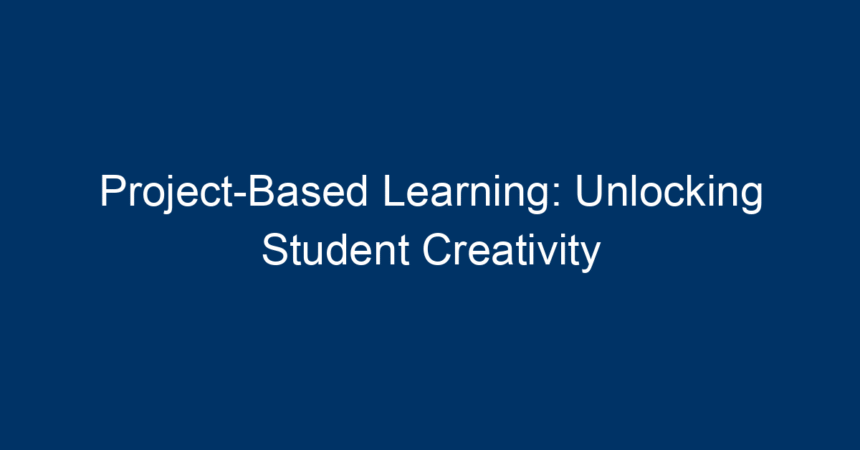In today’s rapidly evolving educational landscape, traditional teaching methods often fall short of igniting student enthusiasm and creativity. Enter project-based learning (PBL). This innovative approach redefines the educational experience, allowing students to engage deeply with content, collaborate with peers, and develop critical skills. In this article, we will explore the intricacies of project-based learning, its benefits, effective implementation strategies, and how it can unleash student creativity.
Understanding Project-Based Learning
What is Project-Based Learning?
Project-based learning is an instructional methodology that promotes active learning through hands-on projects. Unlike traditional rote learning, PBL encourages students to investigate, explore, and apply knowledge in real-world contexts. By working on a project over an extended period, students develop comprehensive skills, including problem-solving, critical thinking, and teamwork.
The Importance of Creativity in Education
In an era defined by rapid technological advancements and global challenges, creativity plays a crucial role. Encouraging student creativity equips them with the ability to think outside the box, adapt to changes, and innovate solutions. Project-based learning nurtures this creativity by providing students with the autonomy to explore topics of interest and express their unique perspectives.
Benefits of Project-Based Learning
Enhances Engagement and Motivation
PBL transforms the educational experience from passive learning to active engagement. When students are involved in meaningful projects, their motivation to learn increases significantly. They become more invested in their education because they see the relevance of what they’re studying. This intrinsic motivation fosters a lifelong love for learning.
Develops Critical Skills
Key competencies such as critical thinking, collaboration, and communication are at the heart of project-based learning. As students work in teams, they navigate challenges, share responsibilities, and devise creative solutions. This collaborative environment not only enhances their interpersonal skills but also prepares them to thrive in a professional setting.
Fosters Independence and Responsibility
Through project-based learning, students take ownership of their learning journey. They are responsible for planning, executing, and presenting their projects. This sense of responsibility nurtures independence, encouraging students to take initiative and develop self-guided learning strategies.
Encourages Real-World Connections
One of the most striking advantages of project-based learning is its ability to connect classroom concepts with real-world applications. By tackling authentic issues, students see the direct impact of their work. This relevance helps them appreciate the subject matter more deeply, making learning more meaningful.
Implementing Project-Based Learning in the Classroom
Step 1: Identify Learning Goals
Before embarking on a project, educators must set clear learning objectives. These goals should align with curriculum standards while allowing room for creativity and exploration. Defining what students should accomplish at the project’s end will guide the entire learning process.
Step 2: Design Meaningful Projects
Projects should be relevant, engaging, and open-ended, enabling students to shape their learning experiences. Encourage students to explore topics they are passionate about or address issues within their communities. This relevance not only increases engagement but also helps foster creativity.
Step 3: Incorporate Collaboration
PBL thrives on collaboration. Create opportunities for students to work together, share ideas, and learn from each other. Group dynamics can boost creativity, as diverse perspectives often lead to innovative solutions. Consider using tools like brainstorming sessions or collaborative platforms to enhance teamwork.
Step 4: Plan for Assessment
Assessing student work in project-based learning requires a flexible approach. Instead of traditional tests, consider project rubrics that evaluate creativity, teamwork, presentation skills, and the application of knowledge. Feedback should be constructive, guiding students on how to enhance their skills continuously.
Step 5: Reflect and Adjust
Reflection is a critical component of project-based learning. After the project, encourage students to discuss what they learned, the challenges they faced, and the solutions they discovered. This reflection not only reinforces learning but also inspires students to improve and take on new challenges in future projects.
Real-World Examples of Project-Based Learning
The Community Garden Project
A remarkable example of project-based learning is the community garden project, where students design, plant, and maintain a garden. This project not only teaches them about biology and ecology but also encourages teamwork and responsibility. Students can learn about nutrition and sustainability while developing their creativity in designing the layout.
The Documentary Film Project
Another innovative example involves students creating a documentary film on a social issue. This project incorporates research, storytelling, technical skills, and public speaking. Students conduct interviews, edit footage, and present their final product, effectively blending various subjects into a cohesive learning experience.
Challenges of Project-Based Learning
Time Constraints
One of the primary challenges educators face is the time required for project-based learning. Projects often take longer than traditional lessons, which can conflict with curriculum pacing. To overcome this, educators must integrate PBL into the existing curriculum strategically, allowing for adequate time management.
Assessing Learning Outcomes
Assessing the outcomes of project-based learning can also be complex. Traditional testing may not adequately reflect student learning and creativity. Developing comprehensive rubrics and using formative assessments can aid in evaluating student performance more holistically.
Resistance to Change
Some educators may hesitate to adopt project-based learning due to unfamiliarity with the approach. Professional development and training can help teachers feel more confident in implementing PBL, showcasing its effectiveness through successful case studies and positive student outcomes.
Actionable Insights for Educators
-
Start Small: Begin by integrating small projects into your lesson plans. Gradually expand to larger, more complex projects as you gain confidence in the PBL approach.
-
Encourage Student Voice: Involve students in the project selection process. Allow them to choose topics that resonate with their interests to enhance engagement and creativity.
-
Utilize Technology: Leverage digital tools and platforms to facilitate collaboration, research, and project creation. Technology can significantly enhance creativity and efficiency.
-
Build a Community of Support: Collaborate with fellow educators, parents, and community members to enrich the learning experience. Community involvement can provide additional resources and create a broader context for projects.
- Celebrate Success: Showcase student projects to parents, peers, and the community. This not only boosts student confidence but also emphasizes the value of their hard work.
Conclusion
Project-based learning is a transformative approach that unlocks the full potential of student creativity. By engaging students in meaningful, hands-on projects, educators can foster a deeper understanding of concepts while developing essential skills for the future. As we navigate an ever-changing world, embracing project-based learning is crucial for cultivating innovative thinkers ready to tackle tomorrow’s challenges. By implementing the strategies outlined in this article, educators can create vibrant learning environments that inspire creativity, collaboration, and a passion for lifelong learning.




